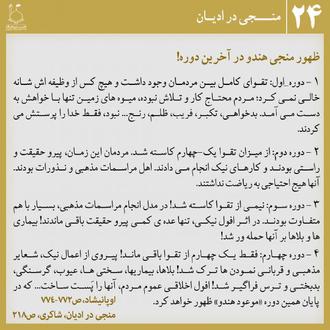What does Mahdism mean and what subjects are included?
Answer: Mahdism is the belief to a certain rise of a divine leader from the progeny of Prophet Muhammad (PBUH) who will come before the end of the world to save humans and promote justice and Islam all over the world that his name is Mahdi.
Mahdism subjects are: all teachings related to Imam Mahdi (PBUH) and knowing the savior, Imam Mahdi (PBUH) in the Quran and narrations, reasons and effects and benefits of the absence of Imam Mahdi (PBUH), the duties of the awaiting people, the signs and conditions of the Reappearance, the characteristics of Imam Mahdi’s (PBUH) companions and feature of his global government, conditions of the world before the Reappearance, Rajaat (return to the world), debate on the prayers and places related to Imam Mahdi (PBUH), Mahdism pathology, the history of the Minor Occultation, Welayat e Faqih (the Guardianship of the Islamic Jurist) and general deputation of Imam Mahdi (PBUH) during the Major Occultation.
We have studied some of these subjects up to now. We will state more in the future. Some books for further readings are: Kamal al-Din and Tamam al-Nimeh, Montakhab al-Athar, Mekyal al-Makarem, Musua’a al-Imam al-Mahdi (the encyclopedia of Imam Mahdi)
What are the characteristics and appearance of Imam Mahdi (PBUH)?
Answer: According to narrations and some valid meetings it could be said that Imam Mahdi (PBUH):
1. Is the most similar person to the Prophet of Islam, 2. Has a beautiful young face, about 30 to 40 years old, 3. Is average, slender and strong in stature, 4. Has a fair-reddish (tawny) complexion, 5. Has long, curly and wavy hair, 6. Has a broad and shiny forehead with the effects of prostration and a black mole on the cheek, 7. Has strong and big shoulders, 8. Has a broad chest, 9. Has big and black eyes, 10. Has drawn and long eyebrows and narrow nose and calves.
(Sources for further study: 1. “Maa’sum e chahardahom (The fourteenth infallible)” authored by Ayatollahi, 2. “Yoosof e Zahra” authored by Ayati, 3. “Mahdi (PBUH), Imam e hazer (Mahdi (PBUH), the present Imam)” authored by Bahadori Nejad, 4. “Gol e Narges (The flower of Narcissus)” authored by Mohamad Ali Shahab.)
Read the rest







